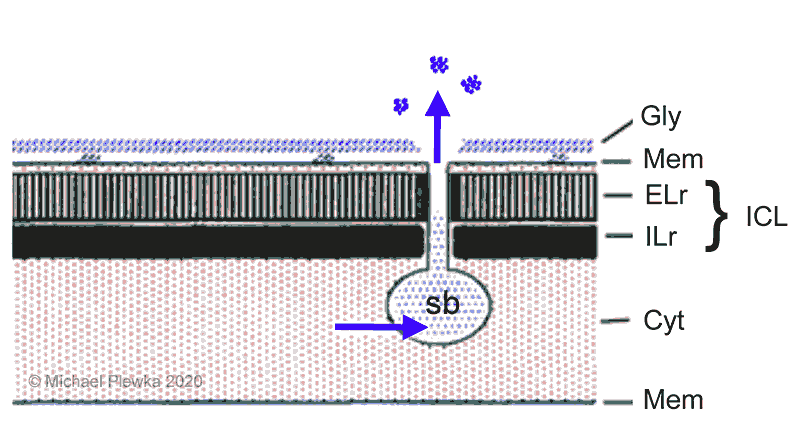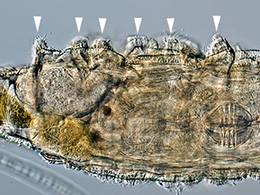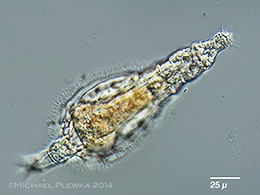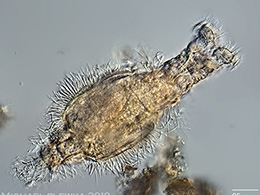The integument (the "skin") of the rotifers has - similar to the skin e.g. of the human being - several layers, as well as pores, but differs fundamentally from the latter by the fact that it consists of a syncytium, i.e. it is a structure in which the cells are fused together.
The lorica that occurs in some rotifers for example Keratella, may lead to the assumption that this is a cuticle, i.e. extracellular secretion, similar to that of arthropods (such as insects or crabs). However such hard parts of the integument or the spines that can be found in bdelloid rotifers like Macrotrachela zickendrahti or Macrotrachela multispinosa are formed intracellularly in rotifers. A diagram of the structure of the integument may illustrate this: |
 |
| Diagram of the integument (after Fontaneto/ DeSmet 2015). Gly: glycocalyx; Mem: cell membrane; ELr: external layer, ILr: electron dense intracellular layer; ICL: intracytoplasmatic lamina; Cyt: syncytial cytoplasm; sb: secretory bulb. |
Depending on the animal species, the lorica is formed by the intracytoplasmatic lamina (ICL). The ICL is located just below the outer cell membrane of the syncytium and is regularly perforated by pores. The cell membrane penetrates these pores and may form spherical bulbs or vacuoles in the cytoplasm. Secretions generated in the syncytium by the cytoplasm are expelled through these secretory bulbs and the pores that cross the ICL (blue arrows). These secretions form a very thin to thick extracellular "cuticle" or glycocalyx to which foreign particles can adhere. Examples of bdelloid rotifers with such secretions are: Dissotrocha macrostyla var. tuberculata, Habrotrocha lata (last image), Macrotrachela plicata. Also monogonont rotifers may have such secretions: see for example Notommata copeus, Proalinopsis caudatus or the housing construction of the sessile rotifer Limnias. The secreted substances include glycoproteins, which also play a role in partner selection and reproductive status.
It looks as if the pores in the bdelloid rotifers can be particularly pronounced (but not necessarily). In the picture below are some examples of integuments, in which the pores can be seen quite clearly, summarized: |
 |
 |
 |
|
Dissotrocha macrostyla tuberculata |
|
|
|
|
|
| Also monogonont rotifers may have such secretions: see for example Notommata copeus, Proalinopsis caudatus or the housing construction of the sessile rotifer Limnias. The secreted substances include glycoproteins, which also play a role in partner selection and reproductive status. |
|
| It looks as if the pores in the bdelloid rotifers can be particularly pronounced (but not necessarily). In the picture below are some examples of integuments, in which the pores can be seen quite clearly, summarized: |
|
| Some conspicuous integuments of various bdelloid rotifers: upper row (from left to right): Pleuretra lineata, Mniobia scarlatina, Macrotrachela punctata; lower row (from left to right): Adineta tuberculosa, Habrotrocha aspera, Dissotrocha aculeata |
| |
| |
|
|
|
| |